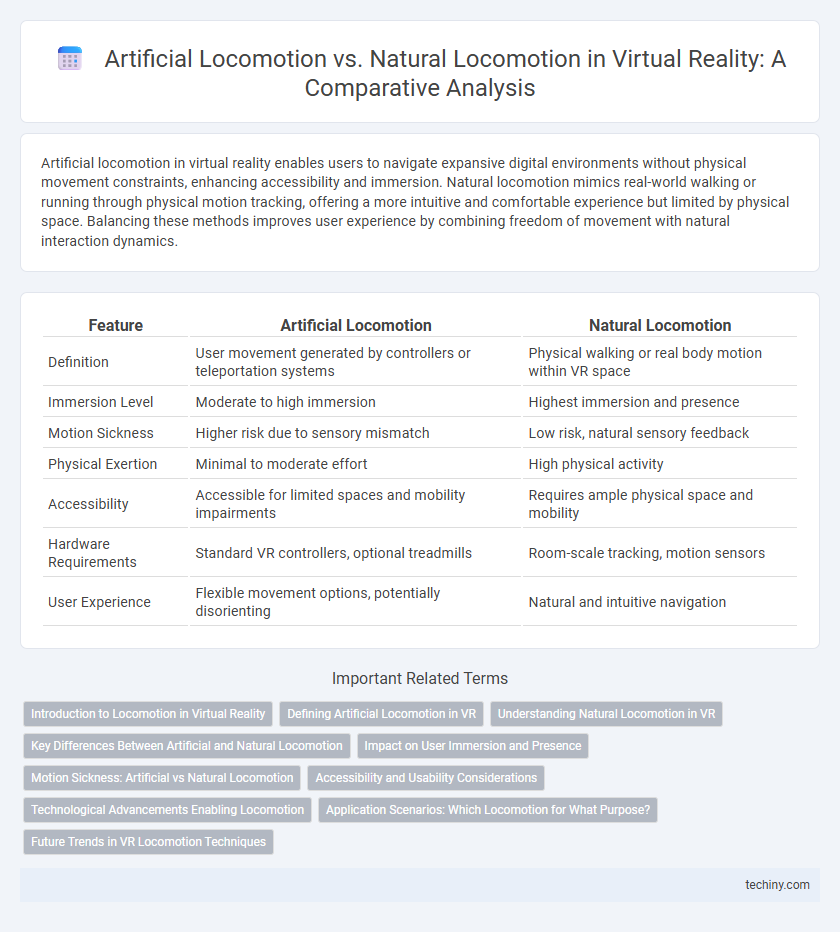Artificial locomotion in virtual reality enables users to navigate expansive digital environments without physical movement constraints, enhancing accessibility and immersion. Natural locomotion mimics real-world walking or running through physical motion tracking, offering a more intuitive and comfortable experience but limited by physical space. Balancing these methods improves user experience by combining freedom of movement with natural interaction dynamics.
Table of Comparison
| Feature | Artificial Locomotion | Natural Locomotion |
|---|---|---|
| Definition | User movement generated by controllers or teleportation systems | Physical walking or real body motion within VR space |
| Immersion Level | Moderate to high immersion | Highest immersion and presence |
| Motion Sickness | Higher risk due to sensory mismatch | Low risk, natural sensory feedback |
| Physical Exertion | Minimal to moderate effort | High physical activity |
| Accessibility | Accessible for limited spaces and mobility impairments | Requires ample physical space and mobility |
| Hardware Requirements | Standard VR controllers, optional treadmills | Room-scale tracking, motion sensors |
| User Experience | Flexible movement options, potentially disorienting | Natural and intuitive navigation |
Introduction to Locomotion in Virtual Reality
Artificial locomotion in virtual reality employs techniques like teleportation, joystick movement, or treadmills to simulate user movement within digital environments, addressing motion sickness challenges common with natural locomotion. Natural locomotion relies on users' actual physical movements, such as walking or running, tracked by sensors to mirror real-world motion in VR, enhancing immersion but limited by physical space. Understanding the differences and applications of these locomotion methods is essential for designing effective, comfortable VR experiences that balance user safety and engagement.
Defining Artificial Locomotion in VR
Artificial locomotion in virtual reality refers to the simulated movement methods enabling users to navigate digital environments without physical motion. Techniques such as teleportation, joystick-controlled movement, and walking-in-place systems create the sensation of movement while minimizing physical space constraints and motion sickness. This contrasts with natural locomotion, which relies on real-world body movements, providing a more immersive but spatially limited VR experience.
Understanding Natural Locomotion in VR
Understanding natural locomotion in VR enhances user immersion by replicating real-world movement patterns, reducing motion sickness and cognitive dissonance. Artificial locomotion techniques, such as teleportation or joystick navigation, often disrupt spatial awareness and presence, whereas natural locomotion leverages physical actions like walking or running within tracked spaces. Advances in motion tracking and room-scale VR environments enable more accurate translation of natural locomotion, resulting in intuitive navigation and improved overall virtual experience.
Key Differences Between Artificial and Natural Locomotion
Artificial locomotion in virtual reality relies on input devices such as controllers, treadmills, or omnidirectional platforms to simulate movement, contrasting with natural locomotion, which depends on users' actual physical walking or running motions. Key differences include sensory feedback discrepancies, where artificial locomotion often lacks proprioceptive and vestibular alignment, potentially causing motion sickness, while natural locomotion provides congruent multisensory inputs. Furthermore, artificial locomotion enables exploration of larger virtual spaces within limited physical environments but may reduce immersion compared to the intuitive and seamless experience of natural locomotion.
Impact on User Immersion and Presence
Artificial locomotion techniques in virtual reality, such as teleportation and joystick movement, can reduce user immersion by creating disjointed or unnatural motion cues that conflict with proprioceptive feedback. In contrast, natural locomotion methods, like physical walking or treadmill systems, enhance presence by closely matching real-world movement patterns, thereby reinforcing sensory congruence and spatial awareness. Studies show that natural locomotion improves spatial memory retention and decreases cybersickness, driving a stronger sense of embodiment within virtual environments.
Motion Sickness: Artificial vs Natural Locomotion
Artificial locomotion in virtual reality often induces motion sickness due to sensory mismatches between visual inputs and the vestibular system, causing nausea and discomfort. Natural locomotion, relying on the user's own physical movements, significantly reduces vestibular conflicts and enhances spatial orientation, leading to decreased incidence of cybersickness. Research indicates that incorporating natural walking or physically tracked movement systems improves user comfort and immersion by aligning proprioceptive and visual stimuli.
Accessibility and Usability Considerations
Artificial locomotion techniques in virtual reality enhance accessibility by enabling users with limited mobility to navigate environments without physical movement, while natural locomotion relies on users' real-world motions, which may limit usability for those with disabilities. Usability considerations must address motion sickness risks and control complexity in artificial locomotion to ensure an inclusive VR experience. Optimizing virtual locomotion methods prioritizes user comfort, reducing input barriers and expanding accessibility across diverse user capabilities.
Technological Advancements Enabling Locomotion
Advancements in sensor technology and haptic feedback systems have significantly improved artificial locomotion in virtual reality, enabling more precise and immersive user movement replication. High-fidelity motion tracking combined with adaptive algorithms creates seamless translation of natural locomotion gestures into VR environments, reducing motion sickness and enhancing user experience. Innovative hardware such as omnidirectional treadmills and wearable exoskeletons further bridge the gap between natural mobility and artificial movement capabilities.
Application Scenarios: Which Locomotion for What Purpose?
Artificial locomotion in virtual reality excels in large-scale exploration and fast movement, ideal for gaming, training simulations, and architectural walkthroughs requiring expansive virtual environments. Natural locomotion offers immersive experiences suited for physical therapy, sports training, and social VR by replicating real-world movement, enhancing user presence and reducing motion sickness. Selecting the appropriate locomotion depends on the application's spatial scale, user comfort, and interaction goals within the virtual environment.
Future Trends in VR Locomotion Techniques
Future trends in VR locomotion techniques emphasize hybrid systems combining artificial locomotion tools, such as omnidirectional treadmills and haptic feedback suits, with natural locomotion methods like room-scale tracking and inertial sensors. Advances in machine learning and sensor fusion enhance motion prediction accuracy, reducing motion sickness and increasing immersion. Emerging neural interface technologies promise seamless integration of user intent with virtual movement, revolutionizing VR navigation experience.
Artificial locomotion vs Natural locomotion Infographic

 techiny.com
techiny.com